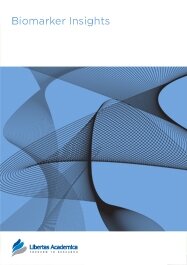

Publication Date: 15 Oct 2012
Type: Original Research
Journal: Biomarker Insights
Citation: Biomarker Insights 2012:7 127-141
doi: 10.4137/BMI.S7799

Exposure to inorganic arsenic induces skin cancer and abnormal pigmentation in susceptible humans. High-throughput gene transcription assays such as DNA microarrays allow for the identification of biological pathways affected by arsenic that lead to initiation and progression of skin cancer and abnormal pigmentation. The overall purpose of the reported research was to determine knowledge building insights on biomarker genes for arsenic toxicity to human epidermal cells by integrating a collection of gene lists annotated with biological information. The information sets included toxicogenomics gene-chemical interaction; enzymes encoded in the human genome; enriched biological information associated with genes; environmentally relevant gene sequence variation; and effects of non-synonymous single nucleotide polymorphisms (SNPs) on protein function. Molecular network construction for arsenic upregulated genes TNFSF18 (tumor necrosis factor [ligand] superfamily member 18) and IL1R2 (interleukin 1 Receptor, type 2) revealed subnetwork interconnections to E2F4, an oncogenic transcription factor, predominantly expressed at the onset of keratinocyte differentiation. Visual analytics integration of gene information sources helped identify RAC1, a GTP binding protein, and TFRC, an iron uptake protein as prioritized arsenic-perturbed protein targets for biological processes leading to skin hyperpigmentation. RAC1 regulates the formation of dendrites that transfer melanin from melanocytes to neighboring keratinocytes. Increased melanocyte dendricity is correlated with hyperpigmentation. TFRC is a key determinant of the amount and location of iron in the epidermis. Aberrant TFRC expression could impair cutaneous iron metabolism leading to abnormal pigmentation seen in some humans exposed to arsenicals. The reported findings contribute to insights on how arsenic could impair the function of genes and biological pathways in epidermal cells. Finally, we developed visual analytics resources to facilitate further exploration of the information and knowledge building insights on arsenic toxicity to human epidermal keratinocytes and melanocytes.
PDF (4.16 MB PDF FORMAT)
RIS citation (ENDNOTE, REFERENCE MANAGER, PROCITE, REFWORKS)
Supplementary Files 1 (4.42 MB TWBX FORMAT)
BibTex citation (BIBDESK, LATEX)
XML
PMC HTML

I would like to extend my gratitude for creating the next generation of a scientific journal -- the science journal of tomorrow. The entire process bespoke of exceptional efficiency, celerity, professionalism, competency, and service.
Facebook Google+ Twitter
Pinterest Tumblr YouTube